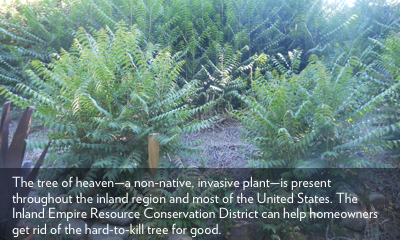Click here if you are having trouble reading The Rutherford Report
 |
|
|
| |
|
|
“Children are the hands by which we take hold of heaven.”
—Henry Ward Beecher |
|
|
|
|
| |
| Invasive Tree No Slice of Heaven |
Its name makes it sound so pleasant, but in truth, the tree of heaven is certainly no slice of heaven.
Also known as the stinking sumac because of the pungent odor it emits when it flowers, the tree of heaven was introduced to North America from China in the late 1700s. It became a popular ornamental tree sold in nurseries in the 1800s, and its hardiness was celebrated in the book A Tree Grows in Brooklyn.
Today, it’s considered an invasive plant that crowds out native vegetation and causes damage to property with its extensive root system.
The tree of heaven can be found growing throughout the San Bernardino Valley. It’s especially present in older neighborhoods.
I learned about the plant from the Inland Empire Resource Conservation District (IERCD)—a public agency based in Redlands that focuses on open space preservation and wildland rehabilitation as well as education and outreach to residents.
Over the course of the past several years, IERCD worked with a group of homeowners in a small, unincorporated area known as Mountain Home Village near Yucaipa to remove or kill more than a thousand trees that had practically taken over the community.
IERCD offers assistance to homeowners within its coverage area who need help getting rid of the tree of heaven, but make sure you’re committed to totally removing the plant before making the call.
That’s because the tree of heaven is very hard to kill.
Simply chopping one down actually stimulates the tree’s root system to begin suckering—a process by which the plant’s roots begin emerging from the soil to create new trees.
Its roots can travel about 90 feet underground to sprout new suckers and begin a new lifecycle, IERCD Lead Field Ecologist Aaron Echols said.
While some smaller trees can be removed manually, an effective and properly applied herbicide is necessary to kill the tree of heaven and prevent it from using its dense, meandering root system to reproduce elsewhere.
If you need help getting rid of a tree of heaven on your property, you can contact the IERCD at (909) 799-7407 or by email at info@iercd.org. |
|
|
|
|
|
| Was The Rutherford Report forwarded to you? Click here to subscribe. |
|
|
|
SUBSCRIBER SERVICES:
Unsubscribe | Help





